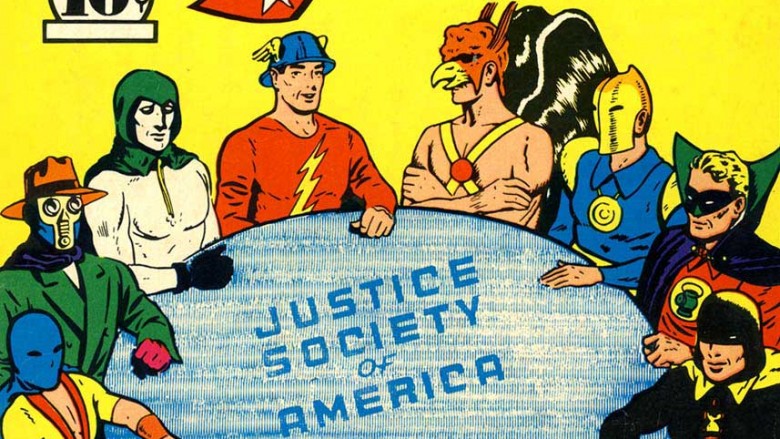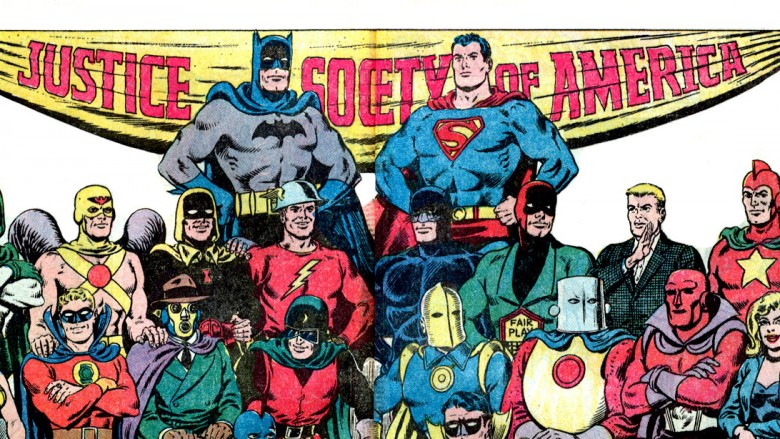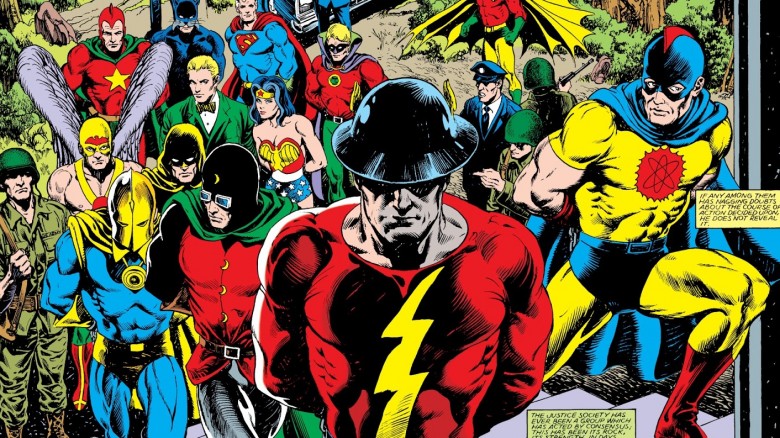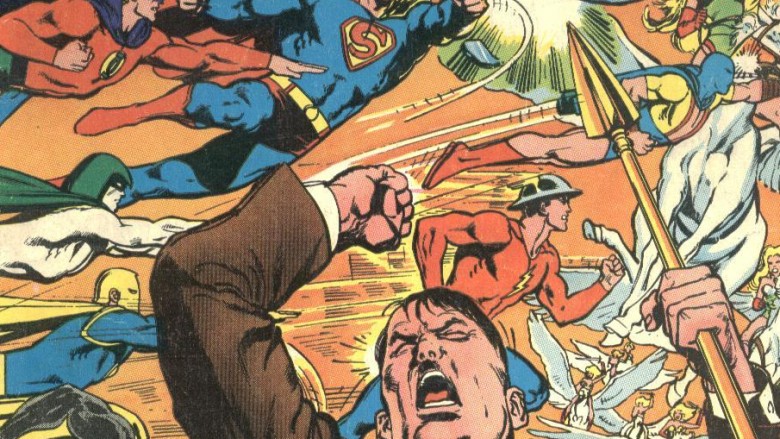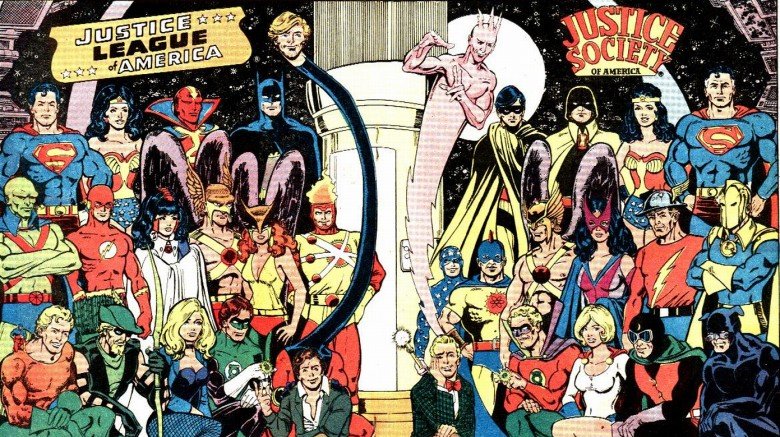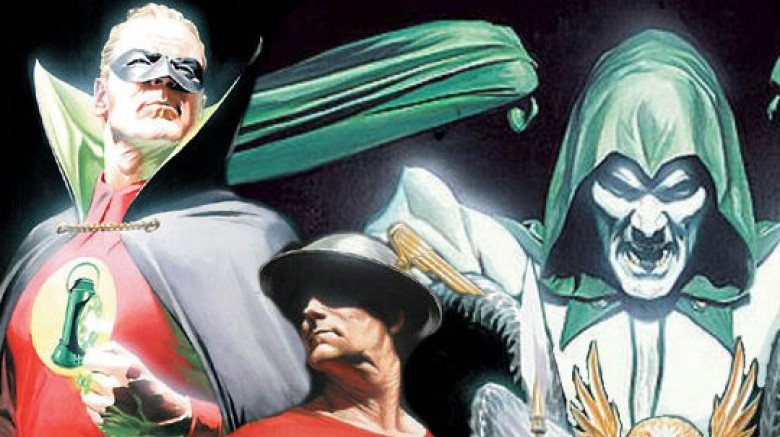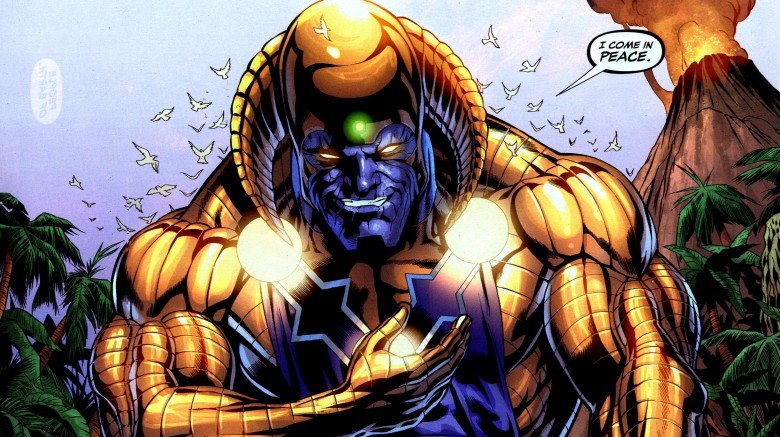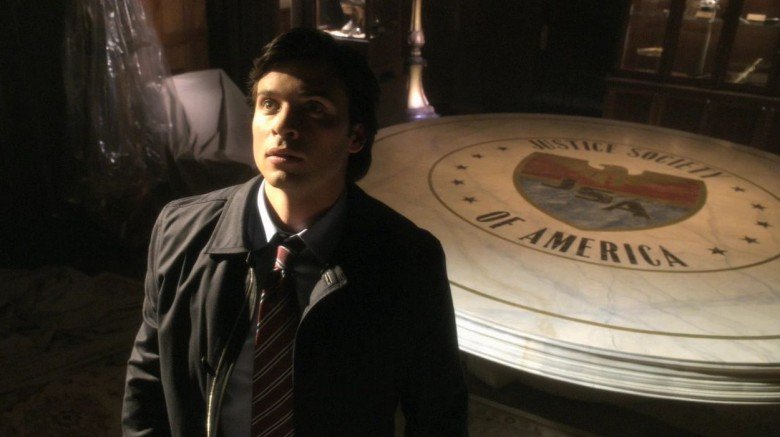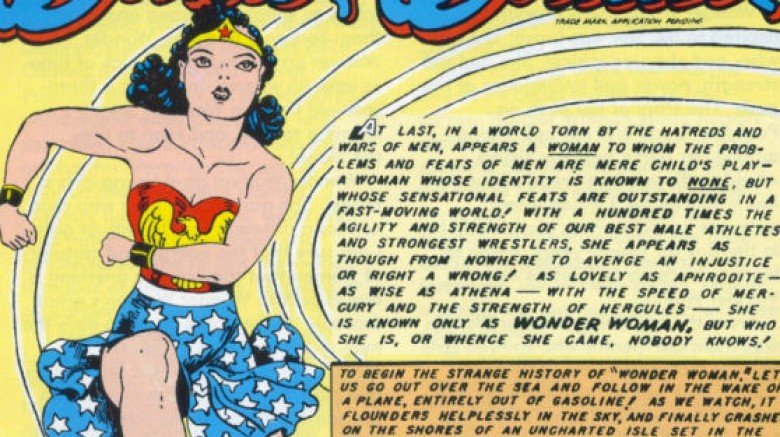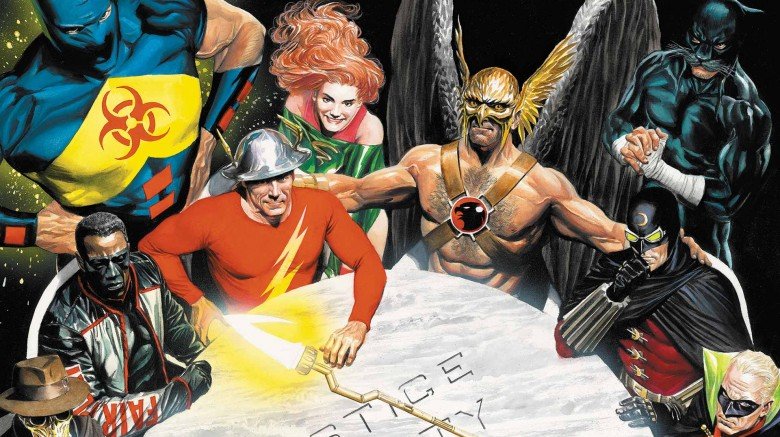The Untold Truth Of The Justice Society Of America
Thanks to their appearance on the CW show Legends of Tomorrow, more people are interested in the Justice Society of America than ever before. Despite the fact that they've been fighting evil together since decades before the world had ever heard of the Justice League or the Avengers, many people aren't nearly as aware of heroes like Jay Garrick and Alan Scott as they are of characters like Batman, Superman, and Wonder Woman. However, that holy trinity of DC characters played their own role in the creation of the company's first family of heroes—and that's just one of many secrets ready to be revealed in the untold truth of the Justice Society of America.
The first superhero team
As the Marvel Cinematic Universe continues to crank out Avengers movies and Warner Bros. prepares to debut Justice League, it's clear that superhero team-ups are a big hit with fans. And when most people imagine iconic superhero teams, it's understandable that they would think about the Avengers and the Justice League. However, the Justice Society of America has both of them teams beat by quite a few years—in fact, they were the first.
In 1940, DC Comics started publishing the aptly titled All-Star Comics. Initially, it featured different stories that showcased a single major superhero at a time. However, the third issue featured almost all of the company's major heroes having dinner together (more than 70 years before Iron Man insisted on taking the Avengers to eat schwarma). There were some weird behind-the-scenes rules about team membership at the time. For instance, the book only featured characters that didn't have their own comics, and when characters like the original Green Lantern and Flash branched out into their own books, they had to become "reserve members." Of course, their membership story isn't half as weird as the one involving Batman and Superman.
Batman and Superman both did and did not start the JSA
During the Golden Age of comics, Batman and Superman were every bit the major stars they are now. Therefore, by the company rules set forth for membership in the Justice Society of America, Batman and Superman couldn't be in the book and were instead considered honorary members. Simple enough, right? It was for awhile, but a later retcon established that neither Batman nor Superman were born when the team were founded, and were therefore never members. A still later story, however, established that Batman and Superman had a wild adventure with the team that would become the JSA, with Superman even suggesting the name. It was all retconned yet again with a post-Crisis story that removed them from the JSA's origin once more.
They clashed with Congress
There are just as many colorful villains as there are strong heroes, so tales about ordinary politics and mundane human evil (like the kind popularized by The Watchmen) seem more like the exception than the rule. However, the Justice Society of America ended up offering some heavy-duty political commentary, although the writers had the power of hindsight on their side.
During the period after World War II, the popularity of Golden Age superheroes diminished greatly, and the Justice Society of America's adventures in All-Star Comics ended in 1951. Superheroes started regaining their popularity roughly ten years later with the launch of DC's Silver Age, but after awhile, readers were naturally curious about where the JSA was supposed to be during the 1950s. DC's explanation, presented in a comic from 1979, was that the team was called before the House of Un-American Activities Committee because of their suspected Communist ties. The team was ordered to reveal their secret identities, and they decided that they were unwilling to do so. Left with no real choice, the JSA disbanded. This tale has been reiterated many times by DC, perhaps because it features the crunchy intersections of identity, justice, and politics.
Hitler kept them out of the war via magic
Speaking of questions belatedly posed by readers, one of the most popular is "why didn't the superheroes go beat Hitler?" Marvel sidestepped this by only acknowledging a handful of active heroes working during that period (easy enough for a company formed only after the war was over), and the Marvel Cinematic Universe furthered this idea by limiting the superheroes during World War II to Captain America. The older DC Comics, however, had the world's first superhero team in the JSA, and they came together during the war years. So why didn't they go beat up Hitler? The short answer is that Hitler wouldn't let them.
The DC Universe has previously established that Adolf Hitler had possession of the Spear of Destiny. In this comics world, the religious relic had actual magic powers. At first, Hitler used it for weird things like summoning Norse myths to fight heroes, but he eventually teamed up with someone named the Dragon King and put a magical forcefield around Axis territory. The field affected anyone that was vulnerable to magic (Superman, for example) and could magically force them to fight for the Axis powers. The Allies, rightfully fearing what would happen if their most powerful heroes became Nazi slaves, kept metahumans like the Justice Society of America away from Axis territory. This allowed the team to focus on protecting the United States while America's soldiers were away, and it also preserved the idea of Hitler and the Axis powers being defeated by the alliance of non-powered human beings.
They are a continuity nightmare
As mentioned earlier, the Justice Society of America was firmly established in the Golden Age of comic books, and then returned to prominence when the Silver Age started a decade later. Launching the Silver Age meant bringing together a new team, one that would become more and more famous over the years: The Justice League. However, editors quickly ran into problems trying to line up continuity between the new JLA and the old JSA, so they decided to make it so the characters' adventures took place on different Earths. Despite being intended to fix continuity issues, this kicked off decades of continuity-related headaches.
Over the years, having multiple characters and multiple Earths grew too confusing, so DC created the original Crisis On Infinite Earths event that ended up condensing everything into one universe. This meant the JSA were a continuity problem again, so DC came up with the idea that the team was stuck in a kind of time loop, preventing a Hitler-triggered Ragnarok from ending the world over and over again. Years later, the company brought the characters out of their limbo, which had the side effect of helping to explain why they were only somewhat old instead of geriatric.
During the Zero Hour event, a villain straight-up murdered several JSA members and super-aged the rest. However, later JSA comics that focused on younger heroes went well, and the older contingent was brought back by writers who forgot about Zero Hour. The JSA eventually had a really strong run starting around 2005, but after the Flashpoint event, DC only focused on JSA adventures in Earth 2, though the subsequent Convergence event seems bound to bring at least some of them back to the "main" reality that DC readers know and love.
They are some of comics' only older heroes
It's something of an open secret in comics that most superheroes are only allowed to age so much. For instance, many of DC's characters have been presented as being perpetually in their mid-30s, which persisted until the New 52 DC event made everyone a bit younger. In this weird environment in which editors are obsessed with luring in young readers with young heroes, it's something of a breath of fresh air that the Justice Society of America are portrayed as older.
This mostly hearkens back to their original role. Since they were a superhero team well before the Silver Age started, DC initially presented them as mentors for the younger heroes, and they embodied this role in the '60s and '70s. When Geoff Johns started writing decades after that, he returned the characters to their roots of mentoring up-and-coming superheroes. Because of the relative age of most of DC's heroes, it wouldn't make sense for them to have mentors close to their own age, so the team is allowed to show their age. However, weird storylines like being stuck in a time-loop Limbo allow DC to have their cake and eat it, too: even though the JSA are nominally old enough to remember the 1930s and 1940s, they're still young and vital enough to pull off the superheroics necessary to bring villains to justice.
They once prevented world peace
Normally, superheroes are presented as shepherds of peace. There's a built-in irony to this, though, as comic books usually present peace as something the heroes obtain by punching evil repeatedly in the face. This is normally the same with the Justice Society of America, but in one notable comic, they had the opportunity to bring peace to the entire world, and ultimately decided that the price was too steep.
The story is featured in the "Thy Kingdom Come" arc, which focused on the Superman from the Kingdom Come Elseworlds event being transported into the JSA's world. That Superman is understandably nervous when he sees that this Earth seems to be on a collision course towards the same future disasters of his own world. Superman and the JSA eventually encounter Gog, a god from another world who is able to re-shape reality at will. He healed the sick, restored vision to the blind, and smote his enemies—pretty much the entire Old Testament package. He was willing to use his powers to heal and unify the world, but only he was worshiped. Unwilling to force the world to obey a god against their will, the JSA end up fighting Gog and taking his head to the furthest reaches of space after they won.
They're made for TV
For many casual fans of the DC Universe, episodes of the CW's Legends of Tomorrow were their first introduction to the Justice Society of America. True to their comic book history as the very first superhero team, however, they've appeared in almost every DC television show. For instance, they were featured in several episodes of Smallville, the Superman-centric predecessor to CW's modern age of superhero soap operas. They were also featured in several episodes of the Justice League and Justice League Unlimited cartoons, as well as Batman: The Brave and the Bold. They were even featured via flashback in the fan favorite cartoon Young Justice and pop up in the opening of the animated movie Justice League: The New Frontier. With all of these cameos, episodes, and show appearances, JSA fans can't help but hope that their own full-length, live-action movie may happen sometime soon.
Wonder Woman was their secretary
Despite her storied history of running around in her underwear and getting tied up by villains, Wonder Woman has become an undeniable feminist icon. She embodies strength, courage, and independence—all qualities that an entire new generation of fans get to see on the big screen via Gal Gadot's DCEU portrayal of the character, and all of which make it unfortunate and ironic that she made her Justice Society of America debut as the team's secretary.
In the comics, this was actually presented as her award for helping the team out with a particular caper in which she mostly hung back while the heroic menfolk went and did their thing. As it turns out, Wonder Woman's creator, William Moulton Marston, wanted to control most of the stories that featured her, so DC gave her very little to do when Marston wasn't able to write, and she only became more active on the team after he passed away. Wonder Woman also created a continuity conundrum after the Crisis On Infinite Earths effectively removed her from the team's Golden Age adventures: in order to explain who was with the JSA at the time, DC created a story that involved Wonder Woman's mother, Hippolyta, traveling to the past, where she decided to stay and be that era's Wonder Woman.
They're magically long-lasting
Even after that whole weird "stuck in Limbo" thing, the average reader might eventually begin to question why the members of the JSA don't look even older, and are still able to fight alongside their much younger fellow heroes. As it turns out, there's a specific reason for this: after the JSA defeated one of their stranger foes, their lives were extended.
The villain in question, Ian Karkull, boasted powers that included access to a realm known as the Shadowlands, which allowed him to manipulate darkness and absorb energy—including temporal energy he stole from the futures of some of his victims. When the Spectre defeated Karkull and the villain exploded, some of that absorbed energy actually seeped into JSA mainstays like the original Flash, the original Green Lantern, Hourman, Doctor Fate, and more. The energy they absorbed slowed down their aging processes—and just like that, DC created a magic explanation for why characters that are actually about a century old are still able to fight alongside their younger counterparts.

